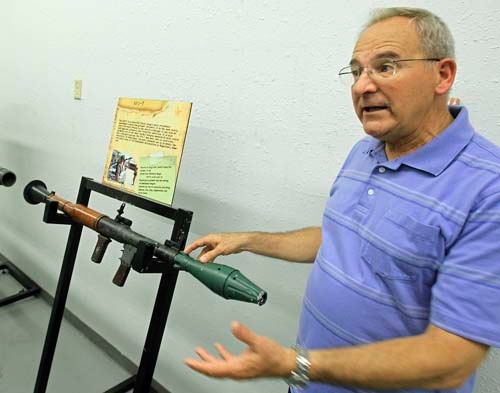Nellis weapons collector retires



A Chinese flag flies over a group of pilots on the Nellis Air Force Base runway, the bloodshot cloth billowing in the breeze. Fighter jets sit close by, painted camouflage in shades of blue to simulate enemy planes.
The American pilots won’t just pretend to fly adversary aircraft. They’re trained to fly as the Chinese do, in their style. And not because it’s better.
"If you know the enemy and know yourself, you need not fear the result of a hundred battles. If you know yourself but not the enemy, for every victory gained you will also suffer a defeat," Bernie Zager reads a quote from Sun Tzu’s "The Art of War" painted on a wall within the base but far from the runway. The walls still shiver from passing fighter jets.
The message has fueled Zager’s life work: Nellis’ Threat Training Facility. Soldiers call it the "petting zoo." It has been dubbed so because they can see up close and touch what is usually off in the distance, unreachable.
But it’s not your usual wildlife.
Zager has spent three decades amassing Russian, Chinese and all kinds of opposing military equipment — tanks, attack helicopters, fighter jets, surface-to-air guns, missiles — at the facility where Sun Tzu’s quote serves as a reminder. Here, soldiers can learn their enemy, stand behind and grab the controls of a Type 54 Chinese heavy machine gun captured in the Vietnam War.
"It’s not a museum. It’s a hands-on threat-training facility," he said.
The tripod-mounted, .50-caliber machine gun might be old, but it’s not obsolete. Forces in the Middle East will pack the gun on a mule’s back and then sit it on a rock or a tree stump to fire.
"As old as they are, they’re one of the most dangerous things out there," Zager said.
The petting zoo serves the same purpose as the American pilots standing beneath the red flag, preparing to take flight as Chinese. Know thy enemy.
Zager is retiring after 21 years in the military and 22 more as a civilian running the petting zoo, but he’s leaving behind much more than just rusty Russian tanks. These weapons have saved lives. That’s the case for many of the collection’s 100 pieces, which the U.S. military has bought, scavenged or captured since the facility opened near the end of the Vietnam War.
"We were losing aircraft in Vietnam but not to other aircraft," he said. "That’s when we got our hands on these anti-aircraft artillery guns. A lot of our commanders here said our survivability rate really increased."
Though the facility started during the Vietnam War, pieces are often older and still used. The oldest is a T-34 Russian tank from the 1930s, still used on the Chinese-Russian border. Soldiers bury them with just the turrets showing, Zager said.
Even some former American military equipment must be studied because it has fallen into less friendly hands.
The facility isn’t open to the public but receives 36,000 visiting military personnel each year. About 1,000 Marines came through before heading to Iraq and Afghanistan to look at Soviet weapons.
From the AK-47 rifle to the SA-2 Guideline missile — which Vietnam pilots called the "flying telephone pole" — a lot of old Soviet Union weapons from the Cold War era have been passed on to terrorists and other threats, he said.
"A lot of countries still have these," Zager said of the 40-foot SA-2 missile behind him, which shot down American pilot Francis Gary Powers in a CIA spy plane in 1960 over Soviet territory.
And that isn’t the largest loot in the yard. A few feet away sits a Mi-24 Hind attack helicopter equipped with wings carrying a four-barrel Gatling gun, anti-tank missiles, bombs and more.
The Russian behemoth resembles the helicopter that Sylvester Stallone battled as John Rambo in the action-movie franchise.
About 30 countries still have this clunky but fast helicopter, which can reach 207 mph.
"There’s a lot of English in the cockpit because it was so exported," Zager said of the helicopter, which came from Fort Bliss, Texas. There, U.S. pilots would study its exterior to prevent confusion between it and friendly aircraft.
But even this aircraft — the most heavily armed helicopter — isn’t the coup of Zager’s career.
"Germany gave us this MiG-23 after the East and West combined," Zager said, then pointing over to the MiG-29, similar to America’s F-16. "This is still being used. We worked hard for this one."
The United States bought 21 of these jets from Moldova in 1997 after learning that Iran was interested in adding the MiG-29 to its inventory.
About 25 countries fly it.
No matter how impressive these jets may be, they’re not the largest threat. That title rests with one of the zoo’s smallest creatures, weighing just a few pounds: the infamous Soviet RPG, rocket-propelled grenade.
"Every night on the news, you can see this somewhere," he said of the rifle-sized weapon rested on the shoulder to shoot. "Kids are running around with these."
About 40 countries use it. Street price, $10.
Zager held the RPG for the last time Friday. During his hardware-hunting days, he has amassed one of, if not the largest, display of foreign weaponry in the country. But he doesn’t count each piece of the collection.
"What’s rewarding is when you know you have an effect on people," he said.
Contact reporter Trevon Milliard at tmilliard@review journal.com or 702-383-0279.












